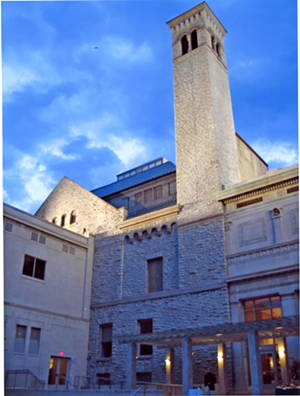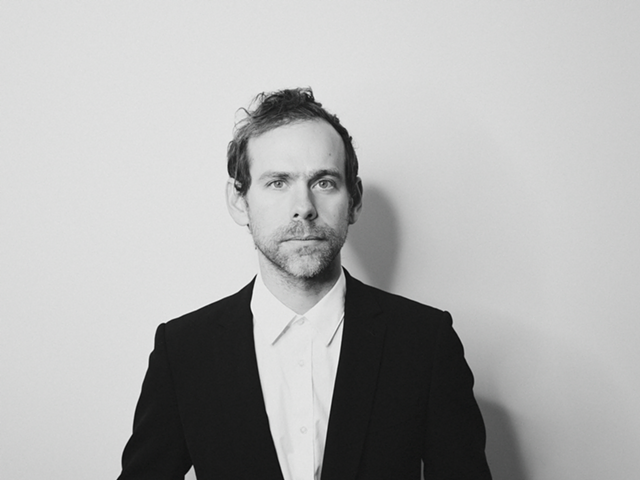That’s what Cameron Kitchin, the director of the Cincinnati Art Museum since 2014, was told — in so many words — when he first spied the secret tower that’s part of the museum’s complex.
“I asked on my tour, seeing all the various spaces created by these buildings, if I could get to the tower and see it,” he says. “And they said, ‘There’s just no way.’ They said the only way would be to construct a ladder on the exterior of the tower and enter it from above.”
He investigated that option, but ultimately decided to illuminate the mysterious tower’s exterior with LED lights shining from other buildings. That started last year, and with the leafless trees of winter you can now notice it from miles away. It’s the highest point on a building that rests atop a hillside in Mount Adams/Eden Park. But it’s been virtually unknown — until recently.
According to museum archivist Geoff Edwards, the tower is a stone-clad cast-iron chimney that was used with the old coal boilers in the museum’s original 1886 building. But by the 1950s, when the museum campus had grown, a new boiler room was created elsewhere and used a shorter “stumpy” stack. The old one became defunct.
It also became impenetrable. There is no entrance or opening — an elevator shaft blocks it on the main floor; other obstacles surround it elsewhere. There’s no access from the outdoor courtyard. And skylights from the third-floor Contemporary gallery prevent rooftop access.
Where some might see a problem — even an embarrassment — in this useless structure, Kitchin saw an opportunity. Light it up! (At one time, it was illuminated, but that stopped long enough ago that the lighting implements were in a decayed state.)
“Within our strategic plan for the museum, we call out that the entire site is a beacon to all of Cincinnati about the importance of arts, culture and education,” Kitchin says. “So it was a simple move to create better visibility and illumination at the highest point of the museum. It’s a small action with a large impact.”
In a separate interview, David Linnenberg, the museum’s chief administrative officer, provided some overview.
“I think Cincinnatians just love history around old buildings,” he says. “Cameron is not trying to add large wings to this building. We’re trying to use the space we have the best we can, including the site. Once we do that, we’ll open people’s eyes to just how old and beautiful the (original) building is.”
Another innovation to making the art museum a nighttime destination is new evening hours: The museum is open until 8 p.m. on Thursdays, with free admission to otherwise-ticketed exhibitions from 5-8 p.m.
The lighting also, perhaps, addresses the fact that the art museum’s 1886 building has been left out of the celebration of older Cincinnati structures like Music Hall, the Cincinnati Museum Center, Memorial Hall and much of Over-the-Rhine. Over the decades, the original building has become but one of nine. The historic 1886 front entrance — already relegated to secondary status — was permanently blocked by construction of the Adams-Emery Wing in 1965, an attractive Modernist building in its own right but not stately. And while the 1906 Schmidlapp Wing did have an impressive entrance, it faces a parking lot and lacks an impactful approach.
Kitchin is trying to make the Schmidlapp entrance more noticeable to all — fundraising has begun on a $7 million project to have a new roadway run past it. And he wants to make the illuminated tower a symbol for all Cincinnati. (Additional lighting will follow.)
“The elegance of the uplighting is exactly what we want in order to give greater knowledge to all as to where the art museum is and how accessible it is,” he says.
Meanwhile, the museum is continuing to leave on display a “temporary” 2014 neon sculpture by Tony Luensman, “CAMPGROUND,” sponsored by ArtWorks and is attached to an exterior wall. And Kitchin sees plenty of future opportunities to use the building as a “canvas” for art installations.
So who knows? If one day you see a long trail of hair falling from the top of the secret tower down to the courtyard below, you’ll know the museum has a new Rapunzel artwork to go with Jim Dine’s signature “Pinocchio (Emotional)” outdoor sculpture.
CONTACT STEVEN ROSEN: [email protected]






